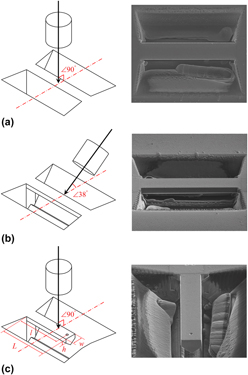Crossref Citations
This article has been cited by the following publications. This list is generated based on data provided by
Crossref.
Lu, Mingyuan
Mead, James
Wu, Yueqin
Russell, Hugh
and
Huang, Han
2016.
A study of the deformation and failure mechanisms of protective intermetallic coatings on AZ91 Mg alloys using microcantilever bending.
Materials Characterization,
Vol. 120,
Issue. ,
p.
337.
Mead, James L.
Lu, Mingyuan
and
Huang, Han
2017.
Inducing stable interfacial delamination in a multilayer system by four-point bending of microbridges.
Surface and Coatings Technology,
Vol. 320,
Issue. ,
p.
478.
Gao, Shang
and
Huang, Han
2017.
Recent advances in micro- and nano-machining technologies.
Frontiers of Mechanical Engineering,
Vol. 12,
Issue. 1,
p.
18.
Mead, James L.
Lu, Mingyuan
and
Huang, Han
2019.
Microscale interfacial adhesion assessment in a multilayer by a miniaturised four-point bending test.
Mechanics of Materials,
Vol. 129,
Issue. ,
p.
341.
Csanádi, Tamás
Vojtko, Marek
Dankházi, Zoltán
Reece, Michael J.
and
Dusza, Ján
2020.
Small scale fracture and strength of high-entropy carbide grains during microcantilever bending experiments.
Journal of the European Ceramic Society,
Vol. 40,
Issue. 14,
p.
4774.
Csanádi, Tamás
Gall, Marián
Vojtko, Marek
Kovalčíková, Alexandra
Hnatko, Miroslav
Dusza, Ján
and
Šajgalík, Pavol
2020.
Micro scale fracture strength of grains and grain boundaries in polycrystalline La-doped β-Si3N4 ceramics.
Journal of the European Ceramic Society,
Vol. 40,
Issue. 14,
p.
4783.
Csanádi, Tamás
Vojtko, Marek
and
Dusza, Ján
2020.
Deformation and fracture of WC grains and grain boundaries in a WC-Co hardmetal during microcantilever bending tests.
International Journal of Refractory Metals and Hard Materials,
Vol. 87,
Issue. ,
p.
105163.
Zhao, Yitian
Lu, Mingyuan
Fan, Zhiqi
McCormick, Paul
Tan, Qiyang
Mo, Ning
and
Huang, Han
2020.
Microstructures and mechanical properties of wear-resistant titanium oxide coatings deposited on Ti-6Al-4V alloy using laser cladding.
Journal of the European Ceramic Society,
Vol. 40,
Issue. 3,
p.
798.
Kreins, M.
Schilli, S.
Seifert, T.
Iyer, A.H.S.
Colliander, M.H.
Wesselmecking, S.
and
Krupp, U.
2021.
Bauschinger effect and latent hardening under cyclic micro-bending of Ni-base Alloy 718 single crystals: Part I. Experimental analysis of single and multi slip plasticity.
Materials Science and Engineering: A,
Vol. 827,
Issue. ,
p.
142027.
Lin, Weikang
Zhao, Yitian
Wang, Feng
Huang, Han
and
Lu, Mingyuan
2022.
Interfacial adhesion assessment of SiN/GaAs film/substrate system using microcantilever bending technique.
Journal of Physics D: Applied Physics,
Vol. 55,
Issue. 24,
p.
245104.
Dehkhoda, Sahar
Lu, Mingyuan
and
Huang, Han
2022.
Adhesion Evaluation of an Embedded SiN/GaAs Interface Using a Novel “Push-Out” Technique.
Micromachines,
Vol. 14,
Issue. 1,
p.
37.
Schlacher, Josef
Csanádi, Tamás
Vojtko, Marek
Papšík, Roman
and
Bermejo, Raul
2023.
Micro-scale fracture toughness of textured alumina ceramics.
Journal of the European Ceramic Society,
Vol. 43,
Issue. 7,
p.
2943.
Puttbach, C.
Prinz, G.S.
and
Murray, C.D.
2024.
Strength and stiffness characterization of ultra-high performance concrete (UHPC) cement paste phases through in-situ micro-mechanical testing.
Cement and Concrete Composites,
Vol. 149,
Issue. ,
p.
105520.





